This morning I had the opportunity to listen in on the presentation by Bruce Mountain and Simon Bartlett on their report (to which Darren Edwards also contributed, and which was released today) titled ‘No longer lost in transmission’ – which presents an alternative plan (a ‘Plan B’) to the VNI-West development being pursued by the AEMO.
I thought it would be useful to include reference to it here, and also the AEMO response which was also published today … though readers should understand that article has been published merely to provide a quick reference – so so should not draw any (mistaken) inference about our positions about this.
| The VEPC Report
No longer lost in transmission |
The AEMO (initial) Response
AEMO responds to VNI West ‘alternative plan’ |
|---|---|
|
The report was made available publicly under ‘Research 2023’ after the presentation … |
I’m not sure how long the AEMO had access to this report before its release today (Wednesday 2nd August 2023), but it was enough time for the AEMO to publish this Media Release on the morning of 2nd August: |
|
There are aspects in the report that touch on loss factors and spillage in and around the infamous ‘x5 constraint’ … and other constraints related to the curtailment of wind and solar in north-western VIC and south-western NSW … which we have noted before is increasing across the NEM, such as: The presentation this morning was recorded, so if that recording is available later (and we see it) we’ll link it in here as well: The presentation was useful for me to gain some sense of what the authors are thinking of the challenges with VNI-West (and transmission development in broader terms) and what they see as the alternative. |
|
|
On p11/91 of the report, this page seems to sum up the guts of ‘Plan B’: |
The authors compare their ‘Plan B’ with what they term as ‘extended VNI-west’ on p37/91:
|
(A) In the media?
In a quick scan of the News Media this morning whilst the presentation was underway, we found the following news articles:
1) In the AFR:
(a) On the morning of its release, Ben Potter wrote ‘The $6b plan to get the energy transition back on track’.
(b) That afternoon, Ben Potter followed up with ‘D’Ambrosio rejects ‘Plan B’ for Victoria’s green grid.
(c) Wednesday evening it featured in Jennifer Hewett’s column ‘Australia’s energy transition is short-circuiting. Here’s why’.
2) In RenewEconomy, Giles Parkinson wrote ‘“Shorter, cheaper, more renewables:” VNI West critics come up with a Plan B’.
3) In the Guardian, Peter Hannam wrote ‘Victorian electricity transmission charges could more than double if Australia’s longest power line proceeds’.
We see that (different aspects of) this article might be referred back to later … (so if you see any other news articles about this analysis, please feel free to add in comments below).
(B) Modellers at 20 paces?
During that infamous RET Review I recall making the comment ‘consultants (or modellers) at 20 paces’ … well, this seems to be another area where this is now occurring.


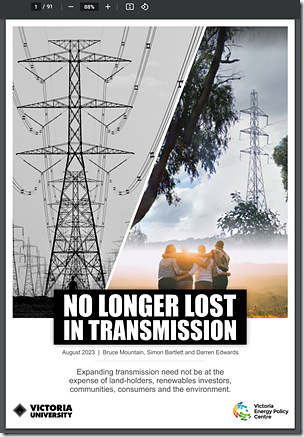
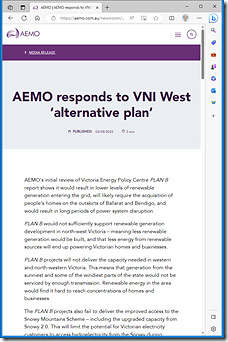
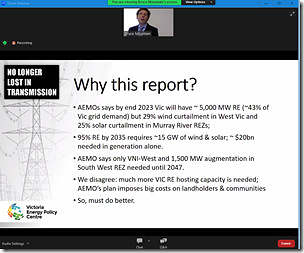
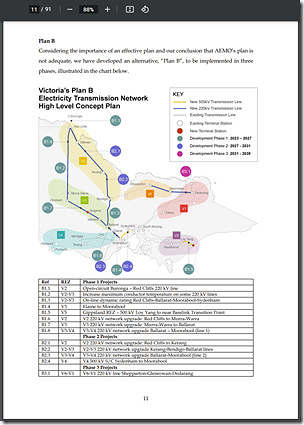
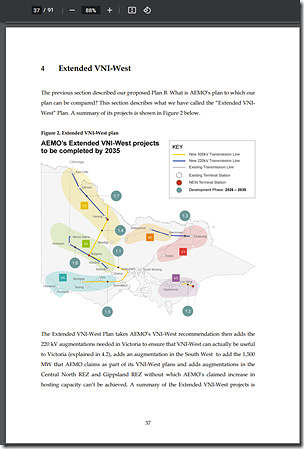
So we have one solution that involves paying $11 billion (plus $5b for Snowy2?) and another that costs $6 billion. This is for transmission to supply renewable energy that costs $50 per MWh plus a RET equivalent of $50 MWh. Not discussed is an alternative that would see no transmission costs but augementation of coal based electricity at $50 per MWh
From the VEPC report:
“The Australian Energy Market Operator (AEMO’s) modelling for the VNI-West Project Assessment Conclusion Report (PACR) shows that AEMO expects that for the next four years the wind farms in Western Victoria will waste up to 40% per year of the electricity that they are able to produce because the transmission system is not able to accommodate their production. The picture is no better with solar farms in the Murray River REZ expected to waste up to 40% per year of their production potential over the next eight years.”
Who exactly is to blame for this? A bunch of international renewables developers failed to model power flows properly when making their investment decisions and now the Australian public have to pay for it with the garbage proposals from the VEPC report? The RETs aren’t doing it? Everyone of us is already rewarding them by paying for environmental certs which we all see at the bottom of our electricity invoices.
Where is this magical $50/MWh coal coming from. Finance, Depreciation and overheads on a new brown coal plant will be about $70/MWh O&M $20-25 and coal $12-20
The curtailment situation is complicated. In the past AEMO was not allowed tell new aspirants if anyone else had applied to build plants near a particular substation because it was “Commercial in Confidence”. Also, it was probably felt that a public access system would encourage a gold rush situation where people just “pegged claims” and held genuine developers to ransom. Net result, too much capacity built in the wrong places because the sun and or wind resource looked good
Minor issue but if they don’t deliver power they don’t get LRECs
“We know, because of rigorous research and analysis conducted by AEMO and the CSIRO, the lowest cost replacement for this coal generation is renewable energy from the sun and the wind – backed up by batteries, gas and hydro to smooth the bumps in production.” [AEMO, from the AEMO (initial) Response linked above.]
The roles of AEMO and CSIRO in arriving at a conclusion that “the lowest cost replacement power…” has returned as a very hot issue, with seemingly both expert groups blaming the other for errors or omissions.
I am eagerly watching progress, eg in newspapers and Twitter. No longer is it only models at 30 paces. It is experts at 30 paces. I have no expert opinion to offer here – I am an interested bystander, but my impression is that there is a capital cost hole that must be addressed in the period pre-2030 and the arbitrary exclusion of nuclear power options is enigmatic.
Peter Farley
I wonder how coal plants in China manage since they too would be up for $120/MWh. Fact is that a coal plant that was allowed to contract in the absence of subsidised wind/solar would operate at ~ 90% availability. Fuel $15 (If it was brown coal fuel would cost <$5/MWh); capex $20; O&M $12
New coal is a non-starter on the grounds that it’s complete and utter lunacy to contemplate building a new machine to turn large amounts of brown coal into even greater amounts of carbon dioxide.